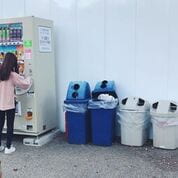
Greener path with invisible cost?
by Sukritta Anantawittayanon, Kobe University
Japan is not a big country when we are speaking about its size; it is obviously small compared to the U.S., after years of disposing of solid waste in landfills, Japan finally faced the land shortage problem. There was not enough area for landfilled waste, especially in large cities where the number of populations increased. The Japanese resident started to concerned more about environmental pollutions that probably created by landfills, which led to the opposition movements and conflicts. Japan needed to find new ways to dispose of their waste.
Jump into the story of energy production, not like the U.S., which had 92.6% self-sufficiency in energy production based on data from EIA in 2017; Japan had only 9.6% energy self-sufficiency. It seemed like we should put these two jigsaws together.
Incineration can decrease the volume of solid waste, and at the same time, it allows us to use the process as energy production. The problem is that there are possibilities that toxic gases might be released to the environment, so the development of methods and technologies is vital. Thanks to the researches and hard work, Japan developed their process to reduce the toxic gas emission while the power generation efficiency is getting higher and higher, so waste incineration can play a significant role in Japan waste management nowadays.
In the other hand, it seems like the energy generated from incineration still cannot get a great job in Japan energy production since the data in 2017 showed that the majority, which is 80.7% total, of power sources were still Natural gas, coal, and oil. The percent of energy from waste incineration did not show up; however, if we assumed that it was included in renewable energy ratio, then it could not be higher than 8% total. It sounds not so bad, but can we indeed include the energy generated from waste incineration as renewable energy?
It is, for me, debatable that can we count waste as the renewable energy source or not, as it is not the infinite resource and created from other resources we took out of our planet. Is it really different from fossil fuel when we talk about it as the power source? Or the words “Energy from waste” just made us an illusion.
Are there any possibilities that the feeling as a waste producer in people can be neutralized by “waste can be used as the power source” thought? While the trend of “Zero waste” spread across countries, it seems harder for Japan to do so. Products still need to be wrapped in layers of plastic for the consumer to appreciate it for seconds. Also, it is too convenient to find local non-plastic packaged products, especially in large cities, in a way, we have no choice even though surrounded by choices.
Some people tried to ask the business to reduce unnecessary plastic in their product, but then the paradox of market works against them, so some of those people decide to raise awareness in consumers instead. Nevertheless, how can we feel that produce more waste is not suitable while there are still some ways to go, the trash in our hand is not going to be genuinely wasted, at least in our perception.
We can include food waste in this scenario too. Japan can produce an adequate amount of food to feed their population, but they still lack self-sufficiency in food production; less than 40%, one of the reasons is because much food has been thrown away along the line. Everybody feels bad about it, but not so bad, at least we know that this country has excellent management, and that waste might be used somehow. Take me as an example, which is notably subjective, I might feel considerably guilty if I used a single plastic straw in Thailand, even though I know that we also have wastes management system there, but when I’m in Japan drinking coffee in a plastic bottle for minutes every day seems more understandable.
To provide an environmentally friendly and capable waste management system, it definitely takes cost in technology development and facilities; however, with researches, we can increase the capacity and decrease that cost. But I still wonder, what it cost in people perception?
Burn Baby Burn: A deeper look into Japanese waste incineration
by Kaelyn Kim, Georgia Tech
Upon taking an hour train ride and an equally lengthy bus ride, we finally arrived at our destination. In front us stood a collection of beautiful buildings, each characterized by vibrant colors and wavy lines. There was a whimsical quality to them, reminiscent of an amusement park of some sort. Although some may mistake these structures as part of Osaka’s Universal Studios, these buildings are in fact an incineration plant, a sludge factory if you will. This facility, known as Maishima Incineration Plant, was intricately designed by an Austrian architect and has become a local tourist attraction. Although not all incineration plants are as visually-appealing as the one in Maishima, incineration plants are located all over Japanese cities as they serve as Japan’s primary areas of waste disposal. This differs from countries such as the United States who rely heavily on landfill sites. So why does Japan choose this method of disposal?
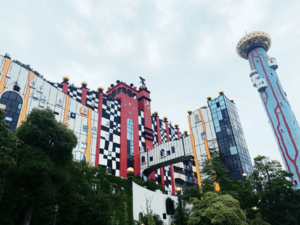
Maishima Incineration Plant
- It saves space.
Japan’s dense population and limited land area make preservation of space a necessity. Landfills require large areas of land that Japan simply does not have. However, incineration is able to reduce trash to 1/15 its original size, and the ash resulting from incineration can be repurposed in a variety of ways. In Japan, ash has been used to form islands, create bricks, and help with other construction endeavors.
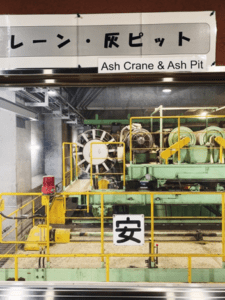 The location for ash collection
The location for ash collection
- It saves transportation costs.
Because Japanese incineration plants have seen great advancements in its safety precautions and have gained the trust of the people, incineration plants are often built in residential or commercial areas. Their proximity reduces waste transportation costs as trucks do not have to travel great distances to drop off trash. Landfills, especially in the United States, are located far from residential areas, and thus large sums of money are allocated towards waste transportation.
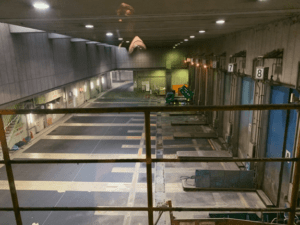
The garbage drop-off area for trucks
- It is time-efficient.
Incineration plants, such as the Maishima Incineration Plant, burn approximately 900 tons of waste per day. Unlike landfills, where stored material takes ages to decompose, incineration plants can burn large amounts of trash in several hours. Additionally, with landfills, trash cannot be disposed of when it is raining heavily or when it is extremely windy. Rushing water can wash pollutants to the ground, and strong winds can carry the trash to surrounding areas. Incineration plants, however, do not need to take these weather conditions into consideration. These facilities can run 24/7.
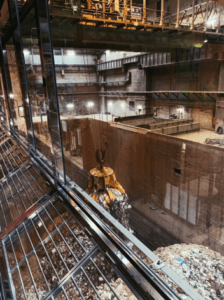
Heaps of waste that will later be burned
- It prevents uncontaminated water and destroys harmful chemicals.
Landfills can often lead to water pollution as leachate (liquid created from garbage) can often seep into the ground, contaminating the water below. This particular issue, however, is avoided with incineration. Incineration facilities also heat trash at temperatures up to 1000° C, destroying harmful germs and chemicals, which is especially useful for eliminating medical waste.
- It is energy-efficient.
Waste incineration is also highly energy-efficient. The heat from incinerators is used to bring water to high temperatures and create maximum steam flows. This steam then powers turbine generators which can generate approximately 4,200kW per day. This electricity is used to power the facility, and any excess electricity is sold to local power companies.
Despite the many benefits of incineration plants, there are costs associated with waste incineration that Japan needs to take into consideration.
- It is expensive.
Both installing and maintaining incineration plants can be quite costly. A tremendous amount of money is spent on incorporating high-tech machinery, purchasing construction material, and obtaining permits. Additionally, because Japan has few resources available, natural gases and coal have to be imported to use for incineration. In the long run, however, incineration may be cost-efficient as it has a less negative environmental impact compared to landfills.
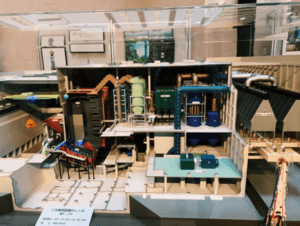
A model of the incineration plant construction
- Smoke generation
If waste is not completely combusted, a cancer-causing substance known as dioxin is released. Waste incineration can also result in the creation of other toxic metals. This is problematic as even small doses of these chemicals can lead to serious health problems. However, in recent years, Japan has put in tremendous effort to mitigate these issues. It has developed bag filters which trap pollutants, created catalysts to decompose dioxin, implemented exhaust cooling to prevent the re-formation of dioxin, and incorporated activated coal that limits dioxin in exhaust fumes. Advancements have also been made in the machinery of incinerator itself to prevent uneven burning, thus reducing the dioxins emitted.
- High levels of CO2
The incineration of organic material releases high levels of CO2, a major greenhouse gas that traps atmospheric heat. However, landfills are equally – if not more – detrimental. When organic material biodegrades in these sites, it produces large amounts of methane, another harmful greenhouse gas.
Discouragement of Waste Reduction
Because incineration plants can burn massive amounts of trash, there have been concerns that this method of disposal discourages waste reduction. However, each person in Japan produces approximately 2 pounds of trash per day; while in the United States, an average person generates 4.5 pounds of trash per day. Japan has also made a significant effort to promote recycling methods.
Overall, taking the efficiency and environmental impacts of both disposal methods into consideration, incineration proves to be the optimal disposal method for Japan. Despite the costs and air pollution involved, Japan has been making continual improvements to reduce the negative environmental impacts of incineration. Thus, the high efficiency and effectiveness of incineration plants far outweigh the costs.
In Japan, there are also very few alternatives for disposing of solid waste. Again, due to Japan’s limited land area, landfills are simply not an option. However, Japan has taken various measures to encourage recycling, an alternate method of disposal. Under the Act on the Promotion of Sorted Collection and Recycling Containers and Packaging, increased efforts have been made to recycle plastic containers and PET bottles specifically. Many of the plastics are then used to create textiles such as car mats and carpets. Various handouts and other forms of advertisements have also been disseminated to encourage local communities to recycle.
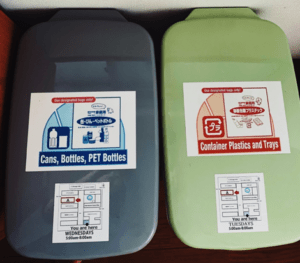
Recycling bins for plastics
Waste disposal management is no easy task. Because Japan is a highly-developed and wealthy nation, it is able to invest in optimizing its waste disposal system. Its advanced technology has enabled it to successfully implement incineration plants that create minimal environmental damage. Incineration plants such as the Maishima Incineration Plant I saw today show how these sites have also been integrated into local areas.
Pros and Cons of Solid Waste
by Thomas Russ, Georgia Tech
Public waste is handled different between in the U.S. and Japan. Overall, Japan does a much better job in managing their solid waste than the U.S., mainly through their different methods of waste management of using landfills and incineration.
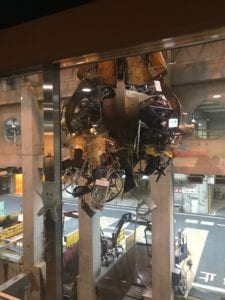 Some of the pros of the U.S. and their use of disposing waste through creating landfills is that the trash is out of the way of the public and displaced in generally remote areas not affecting the population of environment as much as if the trash were still present in the cities and communities. Some cons of the landfill method is that the trash is still there, in that its not completely gone, it was just moved from one place to another, which has the possibility of bringing up future problems for when people have to deal with the trash and where to put it next to make way for more expansion and industrialization. For Japan, some of the pros of incineration is that unlike landfills, the trash is completely burned up, taking up much less space and, for the most part, ridding the environment of the trash leaving only ash to be stored away in controlled, unharmful containment units. One main con of incineration is the harmful gases that could be produced from burning various objects containing different chemicals that can create damaging fumes to the atmosphere.
Some of the pros of the U.S. and their use of disposing waste through creating landfills is that the trash is out of the way of the public and displaced in generally remote areas not affecting the population of environment as much as if the trash were still present in the cities and communities. Some cons of the landfill method is that the trash is still there, in that its not completely gone, it was just moved from one place to another, which has the possibility of bringing up future problems for when people have to deal with the trash and where to put it next to make way for more expansion and industrialization. For Japan, some of the pros of incineration is that unlike landfills, the trash is completely burned up, taking up much less space and, for the most part, ridding the environment of the trash leaving only ash to be stored away in controlled, unharmful containment units. One main con of incineration is the harmful gases that could be produced from burning various objects containing different chemicals that can create damaging fumes to the atmosphere.
While there are chances of incineration plants spouting harmful gases, overall the incineration plants certainly produce more positive energy than landfills. Waste incineration contributes to energy production mainly throughout the incineration plant itself through generating electric power for the plant, heating the floors, heating water, and reheating gas. Any extra electricity generated from the plant is then conveyed to the local community power company to be of use to the public.
The benefits of incineration plants definitely outweigh the limited number of costs, and a way Japan can make their waste management even more efficient and decrease the amount of gases released by incineration plants is exporting their trash elsewhere, preferably to other countries who might want the trash for their own energy usage needs in recycling, reusing, and/or incinerating. This way the trash is still not taking up space in the country, like U.S. landfills, and less trash is being burned resulting in less destructive fumes harming the atmosphere.
While we have yet to perfect a flawless waste disposal system, trash management technology today has come a long way. While in Japan, we’ve had the chance to study municipal solid waste (MSW) disposal in the classroom and experience it firsthand on field trips. Due to the geographic constraints and culture of each nation, Japan and America take very different approaches to waste management.
Solid Waste in Japan
by Elise Koepke, Georgia Tech
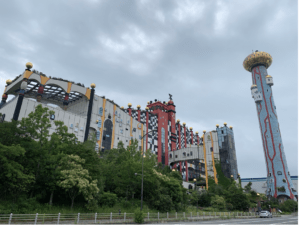
Maishima Incineration Plant
One of the major pros of Japan’s waste incineration system is its effective use of land. While each of America’s many landfills requires hundreds of acres of land, fewer and more compact incineration facilities waste less of Japan’s limited habitable land. Rather than burying MSW and rendering the land useless, Japan’s incineration technology can reduce waste products to more than 1/15th of their original size, minimizing the amount of ash that eventually reaches a landfill. Another benefit of the Japanese incineration system is their society’s ability to embrace the plants and transform them into cultural icons. When we visited the Maishima Incineration Plant in Osaka, we experienced this firsthand – the facility was designed by a world-renowned artist to embody the spirit of the region and is so imaginative that people often mistake it for the nearby Universal Studios. The plant is also equipped with a visitor’s center, guided museum, and factory mascot to promote the experience. This helps to create a more positive image surrounding waste disposal in Japan, while the US citizens largely hold a negative opinion towards landfilling.

Rachel and me at the Maishima Incineration Plant with its mascot “POM”
On the other hand, there are some drawbacks associated with the Japanese incineration system that we are able to evade in America by landfilling. The first is the issue of emissions associated with waste combustion. Incineration releases large amounts of CO2, as well as potent air pollutants such as nitrous oxides and organic carbons. While Japan has installed filters and scrubbers at the plants to reduce emissions, their effectiveness remains uncertain. Another problem with Japan’s MSW disposal system the cost of incineration plants relative to landfills. Because the U.S. has ample cheap land, landfilling is a relatively inexpensive option and can promote commerce between states. Incineration plants, on the other hand, are extremely expensive to construct and costly to maintain.
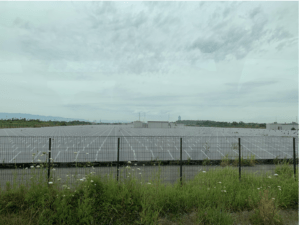
Solar panels built on top of a landfill at Kansai Electric Power
A major upside of Japan’s incineration system is the energy it cogenerates and the ash remnants that can be used for construction. During combustion, the exhaust energy is recovered as steam and harnessed to drive turbines. This process yields electricity for both on and offsite use, making it an effective form of alternative energy. Moreover, ash byproducts from incineration can be melted and cooled to make slag for asphalt and construction materials. This recycled waste is used to pave sidewalks and construct artificial islands such as the airport island where KIX is housed. While it’s hard to definitively determine if these benefits outweigh the environmental and monetary costs of Japan’s incineration system, it is indisputable that these technologies effectively meet the unique needs of Japan’s society.
Due to land constraints, there are few feasible alternatives for Japan’s MSW system. If not landfilled, ash waste could be shipped abroad or dumped at sea, but neither of these options are particularly sustainable or safe. Ultimately, the current incineration system works efficiently for the Japanese and poses no imminent threat in terms of health or sustainability. This is not necessarily the case for the United States, and perhaps we could adapt our MSW disposal system to better fit our unique needs as the Japanese have.
Japan’s Garbage Problems
by Terutada Araki, Kobe University
There are many benefits in incinerating waste.
The merit of incineration is that it reduces the amount of garbage. Japan adopted this way because of its small land. Before the industrial revolution, the main way of garbage disposal was to bury those in the ground. As most of the garbage were biodegradable, some of them are buried on the ground as compost.
However, Japan had to change policy since the population and amount of waste discharged have increased because of industrial revolution. The number of incineration plants become 4 times from1952 to 1975. This happened not only by rise of demand of incineration, also by drastic change in energy supply. Oil enables them to burn garbage cheaper than coal. As a result, in Japan, more than 80% of domestic waste are disposed of in incineration.
The cons of incineration are the running cost. Smoke elimination from the incineration plant are limited strictly. In order to conform to the laws, incineration plants are required to establish purifier. This costs money. Although some plants have generation device, they don’t overweigh the cost. Unlike thermal power station, the amount of fuel is not constant. That’s why power companies are not positive to buy electricity. For low demand of energy production and high running cost, it is difficult to make profits in garbage disposal.
Japan has some alternatives in disposing of solid waste. The most effective way is reducing use of plastic. Japan is one of the most plastic used country in the world. There are a lot of vending machines in Japan, which means that there are a lot of plastic bottles. It is often said that Japanese supermarkets do excessive rapping. Using plastic is not the only way. We can bring my bottle in café. It is common in Germany. Japan has low recycle rate in plastic, which means there are potential to improve.
Municipal Waste Incineration Technology
by Anirah binti Muhammad Shariffudin Teh., Kobe University
The landfill has been one of the standard ways to dispose of trash but unlike other countries, instead of using landfill as the method of waste disposal Japan, disposing of their waste by incineration which is by burning the garbage. By 2009 Japan already had 1243 incineration facilities and Maishima Incineration plant are one of the popular incineration plants with a unique design which look like a theme park.
However, why Japan chooses the incineration process as one of the methods of waste disposal? The first reason is that Japan is an island with a higher population density, which makes landfill not an ideal way of waste disposal, and the other purpose is because incineration promotes better management of trash. The idea of burning the garbage makes it able to reduce the quantity of the waste, so not many spaces are needed to dump the ashes, which is very practical since Japan has a limitation of space. Furthermore, the greenhouse gas that is emitted from incineration is lesser compared to landfill, and the fact that incineration does not produce any toxic element to the groundwater shows that incineration is more eco-friendly than landfill. However, this method also some disadvantages, such as it can contribute to air pollution. The smoke and dioxin generated from the incinerator are harmful and can cause some health issues in the long term.
Fortunately, Japan is very serious in dealing with these problems and had already come out with some plans to make sure that all of the issues under control and not harming their people. For example, chimneys of waste incineration plants emit vapor not smoke, which is not containing harmful substances. Next, the pdf, (https://www.env.go.jp/en/recycle/smcs/attach/swmrt.pdf ), explained how Japan is going to manage its solid waste by using its technology with high-environment prevention capability. More information also can be got from the article, “Advanced Waste Disposal Technology Makes Tokyo the Cleanest City” https://www.japan.go.jp/tomodachi/2015/winter2015/advanced_waste_disposal_technology.html.
Besides, those incinerators are not only burning trash but are used to generate enough energy for the building, and any surplus energy that is made is transmitted to the local power station. Heat energy from the combustion process was used to generate electricity. All of these benefits sound great but are the benefits outweigh the cost? The cost of the construction and instruction the plants may be high, but with some research and development, it is possible to make sure this method as an ideal method I managing waste disposal.
Next, Japan also has an alternative way in disposing of solid waste, which is semi-aerobic landfill, which also known as Fukuoka Landfill method. Semi-aerobic landfill structure enables the land to be used after the area has completed the role as landfills. The structure also allows the landfill to be free from environment problem. More information about how the semi-aerobic landfill function was explained in the pdf (https://www.env.go.jp/en/recycle/smcs/attach/swmrt.pdf) (page 24-28)
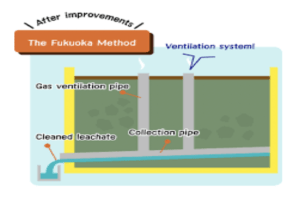
Japan has very systematic methods and plans for waste management. Lots of effort and planning was done to make sure the environment is preserved. Advanced in technology and discipline citizen had to make Japan able to do what they are doing right now and maintain as one of the countries to be exampled by the world.
Solid Waste Management: It’s Not a Waste of Time
by Perrine Kemerait, Georgia Tech
Anyone who thinks that learning about municipal solid waste (MSW) management is a waste of time has obviously never heard of the Maishima Incineration Plant located in Osaka, Japan. The incineration facility, which was concocted in the mind of the eccentric Austrian designer Friedensreich Hundertwasser, is a whimsical building that is reminiscent of a beloved Roald Dahl factory; it has even been mistaken as part of the Osaka Universal Studios theme park. Because of the Maishima Incineration Plant’s eclectic design, it has drawn attention to MSW disposal in Japan, which calls into question the techniques for managing MSW in other countries, such as the United States.
Japan handles its MSW disposal primarily through incineration, while the United States mainly utilizes landfills for MSW management, with each method possessing its own unique set of advantages and disadvantages. This discrepancy in the modes of handling waste is due to Japan’s limited land area, which motivates it to make the most efficient use of its land, while the United States has land to spare, thus making the nation less inclined to condense its solid waste. A benefit of using incineration over landfilling is that it obviously requires less land; although the construction of incineration plants necessitates some land, it is nowhere near as much as the amount needed for landfills. On the other hand, some critics of incineration fear that this practice releases toxic fumes, which can be potentially fatal upon inhalation. However, if the facilities are properly ventilated, such as the Maishima Incineration Plant, fumes and pollutants from this process should not pose a threat. In the case of landfilling, this practice holds the advantage of being more cost-effective and easier to carry out than incineration. Although land must still be designated and prepared for landfilling, this method of MSW management is not nearly as demanding and high-maintenance as incineration. Conversely, the cheapness and ease of landfilling as compared to incineration comes at the cost of increased land usage, environmental degradation, and the fact that landfills are blatant eyesores. In contrast, as exhibited by Maishima, incineration facilities can be designed to look appealing and even inviting.
The beauty of Hundertwasser’s brainchild is not simply in its attractive exterior or its sophisticated and thorough process of MSW disposal; the Maishima Incineration Plant also utilizes some of the steam from its boilers to produce electricity. This steam is employed in many of the facility’s heating needs as well as to power all of its electricity demands. Not only is the electricity generated here used within the plant, but any extra electricity that is created is sold to KEPCO, a nearby power company. Although the process of waste incineration is incredibly intricate with various diverse facets, the benefits certainly outweigh the costs because this practice ensures that MSW is managed as efficiently as possible. In addition, waste incineration has positive externalities such as power generation, not only for the facility itself, but for the local electric company as well.
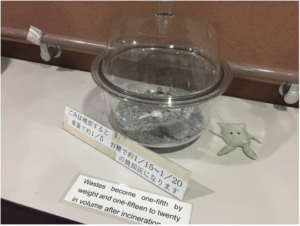 Aside from incineration, Japan’s main alternative form of solid waste disposal is recycling. Even within the Maishima Incineration Plant, recyclable items are sorted out before the incineration process begins to ensure the minimization of waste production. Stemming from the environmental movement that arose following Japan’s rapid period of industrialization in the 20th century, recycling is taken very seriously in Japan. Unlike in the United States, where fewer people take the time to recycle due to the slight inconvenience it poses, recyclable items are sorted accordingly in Japan, from public spaces to private residences. Because of the prevalence of recycling in Japan, this has caused the country’s per capita waste generation to be approximately half of that of the United States.
Aside from incineration, Japan’s main alternative form of solid waste disposal is recycling. Even within the Maishima Incineration Plant, recyclable items are sorted out before the incineration process begins to ensure the minimization of waste production. Stemming from the environmental movement that arose following Japan’s rapid period of industrialization in the 20th century, recycling is taken very seriously in Japan. Unlike in the United States, where fewer people take the time to recycle due to the slight inconvenience it poses, recyclable items are sorted accordingly in Japan, from public spaces to private residences. Because of the prevalence of recycling in Japan, this has caused the country’s per capita waste generation to be approximately half of that of the United States.
The fact that Maishima Incineration Plant doubles as a tourist attraction is significant because of the fact that it draws attention to the importance of proper MSW management. This is not to say that every country should design their waste facilities to look like amusement parks (although that wouldn’t be a terrible idea). However, if other nations were to place as much focus on sustainable MSW practices as Japan, this could induce more conscious usage of natural resources and a decrease in the environmental damage resulting from improper waste disposal.
Japan and Solid Waste
by Johanna Hall, Georgia Tech
Japan’s system of disposing of solid waste is extremely different from that seen in the US. In America, it is typical to dispose of Material Solid Waste (MSW) by putting it in a landfill and essentially burying it. However, in Japan, the more common practice is incineration. As our group learned from the tour of the Maishima Incineration Plant in Osaka, there is a formalized yet complex process that Japan has standardized to incinerate their MSW.
There are many steps the waste takes to get through the incineration plant. First, waste is dumped into essentially a giant pit by garbage trucks, but larger waste is brought to a separate “bulky waste pit” to be dumped. The bulky waste is then sorted into incombustible bulky waste and combustible bulky waste. The bulky waste is funneled through a hammer crusher to make it a more manageable size, then a magnetic separator removes iron and aluminum from the waste so that it can be recycled.
Finally, all the combustible waste is brought to the combustion chamber, where it is burned between 850 and 950 degrees Celsius. The ash left over from burning is about 1/20 of the original volume of garbage and is brought to an ash pit to be buried in a landfill. The toxic gas emitted from the burning then goes through a series of purifiers so that the air released into the atmosphere from the incineration plant is up to Japan’s standard, or around 100-400 ppm. During this air purification process, electricity is generated from the steam. Enough energy is produced to power the entire incineration plant and still have energy left over, which is sold to the Kansai Electric Power Company (KEPCO). This profit is then used to pay the incineration plant’s employees.
One element of this process that especially stood out to me was the fact that the burn ash was approximately 1/20 of the volume of the original waste. In Japan, conserving space is much more of a concern than it is in the US. So, the fact that incineration has the capability to turn the volume of Japan’s waste into 5% if what it originally was is definitely a more sustainable method of waste disposal than simply landfilling the entire volume of raw waste.
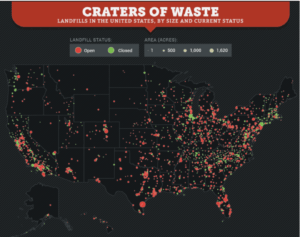 Although the US doesn’t have as many concerns when it comes to land use, this ability to reduce the volume of waste so drastically can still be very valuable. When garbage is landfilled, the possibility for urban development in the area where the landfill is located is essentially eliminated. Landfill sites are not structurally sound enough to build roads or buildings on top of, so that space is often unable to be used for much except as a surface area for solar panels. If the US were to reduce their number of landfills by 95%, a possibility that incineration creates, then there will be more land that could support larger projects, such as building more advanced solar fields or installing wind farms if the land would be uninhabited anyway. However, many landfills are located right outside of large cities, so this land could be used to build residential neighborhoods or parks instead.
Although the US doesn’t have as many concerns when it comes to land use, this ability to reduce the volume of waste so drastically can still be very valuable. When garbage is landfilled, the possibility for urban development in the area where the landfill is located is essentially eliminated. Landfill sites are not structurally sound enough to build roads or buildings on top of, so that space is often unable to be used for much except as a surface area for solar panels. If the US were to reduce their number of landfills by 95%, a possibility that incineration creates, then there will be more land that could support larger projects, such as building more advanced solar fields or installing wind farms if the land would be uninhabited anyway. However, many landfills are located right outside of large cities, so this land could be used to build residential neighborhoods or parks instead.
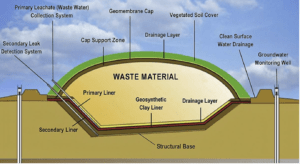 Another element of Maishima’s incineration process that stood out to me was their ability to recapture energy. The fact that the incineration plant is able to generate all of the energy it needs to operate as well as a surplus just from the combustion smoke is very impressive and very sustainable. The plant does not require any use of outside energy because they can generate their own and make profit from it at the same time. This fact alone is a strong argument for the use of incineration plants instead of landfills. Landfills are extremely expensive to build and take up land space, which is becoming a more valuable resource as time goes on. Inside a landfill, there are layers of plastic, clay, trash, more plastic, and dirt, as can be seen in the diagram below, which all take a lot of time and money to put in place. There are also sensors that must be present to detect gas leaks from above the landfill as well as detect water leaks from below. If those occur, they can be detrimental to the environment and people who live near the landfill.
Another element of Maishima’s incineration process that stood out to me was their ability to recapture energy. The fact that the incineration plant is able to generate all of the energy it needs to operate as well as a surplus just from the combustion smoke is very impressive and very sustainable. The plant does not require any use of outside energy because they can generate their own and make profit from it at the same time. This fact alone is a strong argument for the use of incineration plants instead of landfills. Landfills are extremely expensive to build and take up land space, which is becoming a more valuable resource as time goes on. Inside a landfill, there are layers of plastic, clay, trash, more plastic, and dirt, as can be seen in the diagram below, which all take a lot of time and money to put in place. There are also sensors that must be present to detect gas leaks from above the landfill as well as detect water leaks from below. If those occur, they can be detrimental to the environment and people who live near the landfill.
In incineration plants, everything is much more closely regulated and controlled. It is much less likely for a leak to occur or for waste to escape into the natural environment, which might occur in a landfill if, for example, an earthquake displaced the trash. At the same time, it is much more cost-effective and energy-efficient to reclaim some of the energy that took to make the products that are being disposed of through the process of generating electricity with the smoke from combustion.
Another method of waste disposal that Japan has implemented is creating man-made islands by compressing their waste, an example of which can be seen in the image below. Although there are benefits to this in that Japan can repurpose their waste to create more land space, which is in high demand in Japan, the costs seem to outweigh these. This process often causes chemicals from the waste to leach into the ocean, which hurts the marine environment. There is also a risk for the waste to become displaced as a result of an earthquake, which is a common occurrence in Japan. So, this method is not ideal, and it seems that Japan’s best option is incineration.
In any method of waste disposal, there will be pros and cons. There is no perfect way to deal with MSW as there will always be residual waste left over, whether it’s just the raw waste as in the American model of using landfills or it’s incinerator ash left over from combustion as in the Japanese model of incineration. However, after learning about the process that the US takes to landfill and the process that Japan takes to incinerate, I believe that the benefits of incineration far outweigh the costs. I believe that for both the US and Japan, incineration is the more sustainable and smart way to dispose of MSW. Not only does it reduce the sheer volume of waste, but it also allows companies to reclaim all of the energy that it takes to burn the garbage, as well as make a profit off the excess energy. Although the idea of incinerating garbage can be off-putting to many Americans, I believe it is far more sustainable than using landfills and can have significant benefits in the realms of land, energy, and environmental conservation.
Waste Incineration
by Manami Maruyama, Kobe University
Waste incineration is the garbage disposal skill which aim to reduce volume of waste, make harmless, and recycle by burning. Mostly Japan’s garbage disposal way is incineration. The number of garbage incineration facility is the largest in developed countries. Because Japan doesn’t have a land wide enough to be landfill. Most of the developed countries take a system of solid waste in landfills like America.
What are the benefits of waste incineration? The main benefit is that it is hygienic. In the past, people suffered from odors and water pollution caused by landfills. Waste incineration solves such problems. In fact, Japan’s incineration developed in the wake of the spread of the epidemic in the Edo period. Of course, incineration is good way for reducing volume of waste. Japan don’t have enough land to make large landfills. People come to divide waste minutely for incineration. In America, people have to divide garbage into resources waste and usual waste, but in Japan, people have to divide more finally. The fact involves the ease of recycling in Japan.
Conversely, what are the limits of Japanese incineration? First, it needs incinerator, so it costs more than landfills. Second, incineration may generate some harmful chemical substances by incomplete combustion. Third, the number of Japanese incinerators is too much for the need, so the occupancy rate is very low. Therefore, energy loss is occurred and carbon dioxide is discharged wastefully.
The one way of that garbage contribute for energy production is waste power generation. As shown below, in Japan, the rate of incineration and energy recovery is very high.
How to generate energy from garbage? We use the heat that generate with incineration to make high temperature and pressure steam. The steam turns the turbine and generate electricity. Now, the power generation efficiency is increasing, but compared to the potential of waste generation, it is insufficient. One of the causes is the low occupancy rate. Because small sized incinerator can’t generate sufficient energy. The profitability does not fit. If the energy loss will be more least, we can generate more energy sustainability and economically. In Japan, we incinerate waste, so waste power generation is very good way to generate energy. We have to know and consider our waste disposal method and aim better way.
Trash to Treasure: Cost/Benefit Analysis of Waste Incineration
by Rachel Titshaw, Georgia Tech
The daily waste patterns in America and Japan act as representative microcosms of the country’s’ respective large-scale waste management. Japan’s streets are free of waste; meanwhile, it is hard to go a block in America without stepping on someone else’s empty Coke can. Perhaps this is in part due to Japan’s high inclination to communalism, creating a stigma around soiling public space. Then again, maybe it is due to the general strict nature of the culture. Whatever the cause, though, Japan’s lack of trash on the ground permeates into their large-scale disposal system, which consists mainly of waste incinerator plants. Compare this to the common landfill in America. It is just as difficult to drive around without seeing a landfill as it is to walk around without seeing trash on a walk down the road. While neither waste incineration plants nor landfills are flawless waste management systems, it is important to understand why each country has the common method that they do.
Japan, for example, has few choices for mass waste disposal, with incineration plants being the most efficient. Much of their efficiency is specific to Japan, though, as the country has little land area to begin with, and only a fraction of it is usable. Landfills are not an option to them as Japan lacks the land to fill, but the incinerators that they do use serve multiple purposes. Not only are they used to get rid of trash, they are also used to create energy. It was truly impressive while visiting the famed Maishima Plant in Osaka (and their beloved mascot POM) to hear about how the factory can create while it destroys. In essence, they clean the smoke from their incinerators, allowing the exhaust gas to spin their turbine and essentially run itself.
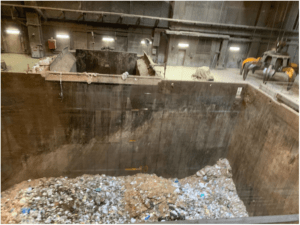 This is just one plant, though, and a very unique one at that. Maishima is famous for its zany architecture and goes so far as to bring tourists to its gates, so their funding is much higher than the average plant. This means that not all incinerators have this energy technology, and they are not by any means a positive influence on the environment. There are still fumes being released into the air via the burned waste, and incineration plants are costly to run in comparison to other waste management methods. The only other places that Japan could put their trash, though, would be in their mountainous uninhabitable land or in the ocean, both of which would cause more problems than they would be worth. Environmentally and economically speaking, it would be very difficult to justify anything other than the current plant. Despite the faults and expensive upkeep, it remains clear that incineration is Japan’s best option.
This is just one plant, though, and a very unique one at that. Maishima is famous for its zany architecture and goes so far as to bring tourists to its gates, so their funding is much higher than the average plant. This means that not all incinerators have this energy technology, and they are not by any means a positive influence on the environment. There are still fumes being released into the air via the burned waste, and incineration plants are costly to run in comparison to other waste management methods. The only other places that Japan could put their trash, though, would be in their mountainous uninhabitable land or in the ocean, both of which would cause more problems than they would be worth. Environmentally and economically speaking, it would be very difficult to justify anything other than the current plant. Despite the faults and expensive upkeep, it remains clear that incineration is Japan’s best option.
That being said, though, incineration leads to a problem that is impossible to see. That is, Japan does not truly see how much waste they are creating because it is not laid out in front of them like it would be in a landfill.
Most of the waste we saw at the plant today was plastic bags and packaging, and these are things that Japanese people use on a daily basis without even thinking about it. Since the amount of waste they put out has no visible, immediate effects, though, they do not believe waste management to be an imperative issue. There has recently been action to diminish plastic waste in Japan, but this may be easier said than done as everything in Japan has plastic packaging. Despite this struggle, though, Japan’s waste management is to be praised for its efficiency and ability to create revenue, energy, and even tourism.
 Individuals in Japan separate their waste into several different containers to reduce the work done by waste management companies.
Individuals in Japan separate their waste into several different containers to reduce the work done by waste management companies. Students from GT and KU in front of the Maishima Incineration Plant after out tour of the facility.
Students from GT and KU in front of the Maishima Incineration Plant after out tour of the facility.